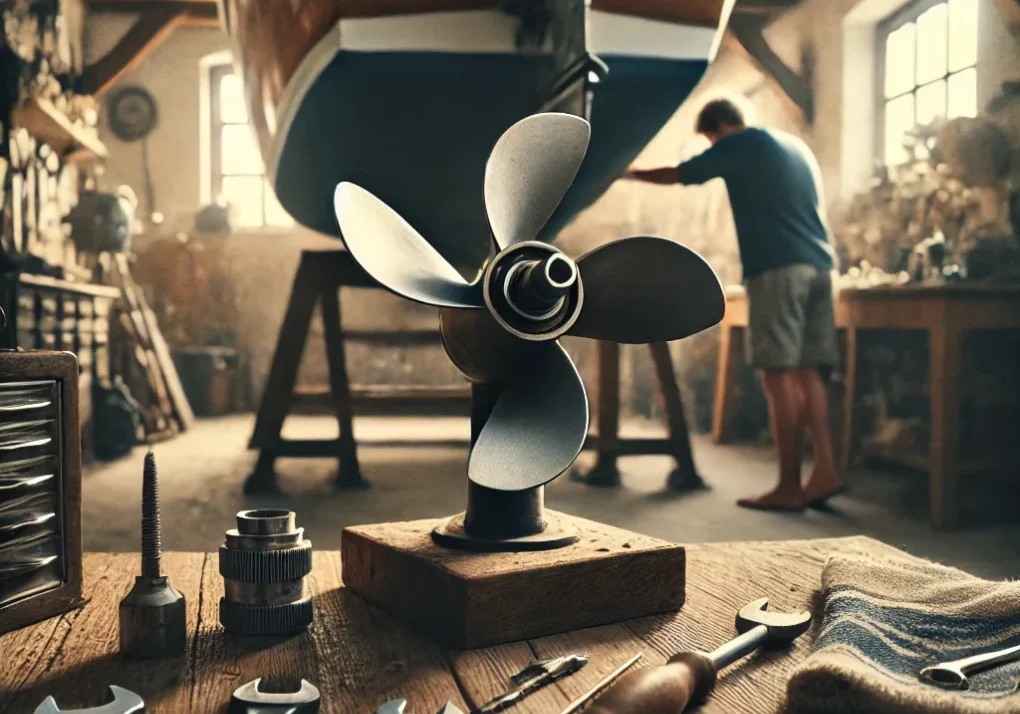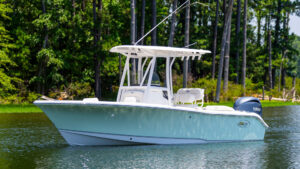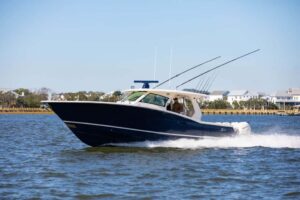Understanding Propeller Pitch and Boat Performance

Ask any group of boaters about performance, and the conversation will eventually turn to propellers. One of the most important and often misunderstood factors is propeller pitch. The right pitch can transform how your boat accelerates, how fast it runs at wide open throttle, and even how efficiently it burns fuel. The wrong pitch, on the other hand, can rob your engine of power and shorten its life. Understanding what pitch means and how it affects your boat is the first step toward dialing in the performance you want.
Quick Answer: What is Propeller Pitch?
Propeller pitch is the distance a boat propeller would travel forward in one full rotation if it were moving through a solid surface, much like how a screw moves into wood. In simple terms, a 21-pitch prop is designed to move the boat forward 21 inches with every turn. Lower pitch props give you quicker acceleration, while higher pitch props deliver more speed once you’re underway.
What is Propeller Pitch?
At its core, propeller pitch is a measurement of how far a propeller would move forward in a single revolution if it were turning through a solid medium instead of water. Think of it like the threads on a screw: each twist drives the screw deeper, and each turn of the propeller pushes the boat forward.
For example, a propeller with a 21-inch pitch is designed to move 21 inches ahead with every rotation. In reality, boats don’t achieve the full distance because water is a fluid medium and there’s always some slip. That “slip” isn’t a flaw, it’s what allows the propeller blades to grip the water and keep the boat moving.
So how is pitch measured on the prop itself? Each blade is angled in relation to the hub, and that angle determines how far the propeller would advance with every turn. A lower angle means a lower pitch, giving you quicker acceleration but less top-end speed. A steeper angle means a higher pitch, which requires more power to turn but lets the boat travel farther with each rotation. Prop manufacturers calculate and standardize this angle, stamping the pitch number directly on the prop, usually alongside the diameter, for easy identification.
Pitch is often confused with diameter, but the two are very different. Diameter measures how wide the circle of the propeller is, while pitch measures forward movement per revolution. Both affect performance, but pitch is usually the first adjustment boaters look at when trying to improve acceleration, top speed, or fuel economy.
How Propeller Pitch Affects Performance
Pitch isn’t just a number stamped on the side of the propeller—it’s one of the biggest factors in how a boat performs on the water. From acceleration to top speed to fuel efficiency, the pitch you choose directly shapes the experience at the helm.
Acceleration and Hole Shot
Lower-pitch props, usually in the 15–19 inch range, allow the engine to reach higher RPM more quickly. The result is faster acceleration and a stronger hole shot, which is why tow boats, watersports enthusiasts, and heavily loaded boats often run lower-pitch props. The tradeoff is reduced top-end speed once the boat is on plane.
Top Speed
Higher-pitch props, typically 21 inches or more, are designed for covering more distance with each revolution. They require more power to spin up but reward you with greater top speed once the boat is running. Performance and offshore boats often favor higher-pitch props for long-distance cruising or high-speed runs. The downside is slower acceleration out of the hole.
Engine RPM and Efficiency
Pitch has a direct relationship with engine RPM. Too much pitch, and the motor struggles to reach its recommended wide-open throttle range, straining the engine and lowering performance. Too little pitch, and the engine over-revs, wasting fuel and risking premature wear. As a general rule of thumb, every one-inch change in pitch results in a 150–200 RPM difference at wide-open throttle.
Load and Usage
Your typical boating style plays a big role in the right pitch choice. If you frequently carry heavy loads or pull skiers and tubers, a lower pitch helps the boat get on plane and handle the weight. If your boating is mostly light-load cruising, a higher pitch maximizes efficiency and speed at steady throttle.
In short, lower pitch favors acceleration and heavy loads, while higher pitch favors speed and long-distance cruising. The right balance is always tied to your engine’s RPM range and how you plan to use the boat.
Choosing the Right Propeller Pitch
Finding the right pitch is less about chasing the highest speed or quickest hole shot and more about matching your boat, engine, and boating style. A propeller that’s perfectly suited for one setup can be completely wrong for another, which is why boaters often test several before settling on the best fit.
Start with Your Engine’s Specifications
Every outboard or sterndrive has a recommended wide-open throttle (WOT) RPM range. This is the sweet spot where the engine makes power efficiently without over-revving. Your propeller pitch needs to let the motor reach that range when you’re running light and trimmed out. If you’re too far below, the pitch is too high; if you’re consistently over, the pitch is too low
Evaluate Your Performance Priorities
Think about how you actually use the boat. If you tow wakeboarders, skiers, or tubes, or if you often carry a heavy crew, you’ll likely be happier with a lower pitch prop that delivers stronger acceleration. If you cruise long distances, fish offshore, or just want a higher top speed, a higher pitch may be the smarter choice.
Understand the Rule of Thumb
A single inch of pitch can make a noticeable difference. As a general rule, every one-inch change in pitch will alter engine RPM at wide open throttle by about 150–200 RPM. That’s why fine-tuning props often comes down to testing one size up or down to dial in your setup.
Test, Don’t Guess
Even with guidelines, real-world testing is the only way to be sure. Swap props if possible and measure the results: how quickly does the boat get on plane, what RPM you’re turning at WOT, how fast you’re running at cruising throttle, and how fuel burn looks across the range. Those numbers will tell you more than theory alone.
Get Professional Input
If you’re still not sure, a propeller specialist or marine dealer can provide expert advice. They’ll look at your hull design, engine size, and usage patterns to recommend a pitch and even a blade style that best suits your boat.
Pros and Cons of Changing Propeller Pitch
Swapping to a different pitch propeller can feel like a quick performance upgrade, and in many cases it is. But just like any change, there are benefits and tradeoffs to weigh before making the switch.
The Upside
Changing pitch is one of the simplest ways to fine-tune how your boat performs. A lower pitch can transform a sluggish hole shot into a quick jump on plane, which is great for watersports or heavy loads. A higher pitch can unlock more top-end speed, letting you cover water faster on fishing trips or long cruises. In many cases, the right pitch also improves fuel economy by keeping the engine within its recommended RPM range.
The Tradeoffs
Every gain comes with a compromise. Lower-pitch props improve acceleration but cut into top speed. Higher-pitch props add speed but can leave the boat slow to get moving. Stray too far in either direction and you risk more serious consequences—like over-revving an engine with too little pitch or straining one with too much. Both situations waste fuel and can shorten engine life.
The Balance
That’s why prop pitch adjustments are rarely about extremes. The best results usually come from small changes, one or two inches of pitch, tested against your engine’s WOT range and your boating style. Done right, it’s one of the most cost-effective ways to make your boat feel tailor-made for how you use it.
FAQs: Propeller Pitch
If the pitch is too high, the engine may struggle to reach its recommended wide-open throttle (WOT) RPM range. This creates strain on the motor, reduces acceleration, and can lower overall performance. Over time, consistently running below the correct RPM can shorten engine life.
A pitch that’s too low lets the engine rev past its intended WOT range. While acceleration may feel strong at first, over-revving wastes fuel and increases wear. In extreme cases, it can even lead to engine damage if left uncorrected.
Yes, fuel economy is directly tied to how well the prop matches your engine. Too much pitch and the engine works harder than it should; too little pitch and it revs inefficiently. The right pitch keeps the motor in its optimal RPM band, where it produces the most power per gallon of fuel.
Higher-pitch props are designed for speed. They let the boat travel farther with each revolution, which increases top-end performance. The tradeoff is slower acceleration, so they’re best for lighter boats or applications where covering distance quickly matters.
Lower-pitch props shine when it comes to hole shot and quick planing. They allow the engine to reach higher RPM faster, making them ideal for towing sports, heavy loads, or situations where rapid acceleration is more important than raw speed.
The simplest way is to run the boat at wide-open throttle and check engine RPM. If the engine falls within the manufacturer’s recommended WOT range, the pitch is correct. If RPM is consistently too high or too low, you’ll need to adjust pitch up or down.
Not if it’s done correctly. Small adjustments, one or two inches of pitch, are common and safe. Problems only arise if the pitch puts the engine outside of its recommended RPM range for long periods. That’s why testing and monitoring RPM is essential whenever you switch props.
Final Thoughts on Propeller Pitch
Propeller pitch might seem like a small detail, but it has an outsized impact on how a boat performs. The right pitch keeps your engine in its sweet spot, balancing acceleration, speed, and fuel efficiency so every outing feels smoother and more predictable. The wrong pitch can do the opposite, robbing you of performance and even putting extra stress on the motor.
Whether you’re chasing top-end speed, pulling skiers, or just looking for better cruising efficiency, taking the time to match your propeller pitch to your boat and engine is one of the smartest performance decisions you can make. Test when you can, keep an eye on your RPM range, and don’t hesitate to get advice from a prop specialist. A well-matched prop doesn’t just improve numbers on a gauge, it makes your entire boating experience better.
Follow us on Social Media!
Search
Recent Posts
When dreaming of owning a boat,…











